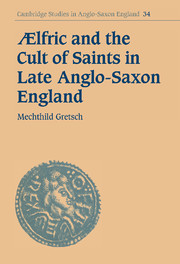Book contents
- Frontmatter
- Contents
- Preface
- List of abbreviations
- 1 Ælfric's sanctorale and the Benedictional of Æthelwold
- 2 Gregory: the apostle of the English
- 3 Cuthbert: from Northumbrian saint to saint of all England
- 4 Benedict: father of monks – and what else?
- 5 Swithun and Æthelthryth: two saints ‘of our days’
- 6 Epilogue
- Bibliography
- Index of manuscripts
- General index
6 - Epilogue
Published online by Cambridge University Press: 22 September 2009
- Frontmatter
- Contents
- Preface
- List of abbreviations
- 1 Ælfric's sanctorale and the Benedictional of Æthelwold
- 2 Gregory: the apostle of the English
- 3 Cuthbert: from Northumbrian saint to saint of all England
- 4 Benedict: father of monks – and what else?
- 5 Swithun and Æthelthryth: two saints ‘of our days’
- 6 Epilogue
- Bibliography
- Index of manuscripts
- General index
Summary
In the foregoing exploration of the five saints' Lives I have employed a strictly historical approach. By examining historical evidence of various kinds I have sought to glean as much information as possible about the standing of the five saints and the popularity of their cults by the end of the tenth century, when Ælfric set about composing their uitae. The evidence provided by Latin hagiography and surviving liturgical books and calendars combines with our ever-increasing understanding of the political events that were witnessed by Ælfric, and of the intellectual and spiritual world in which he grew up. If we add to this Ælfric's own remarks, concerning contemporary events, his perception of the past, his own intellectual training and the cult of saints, a reasonably clear picture may be obtained of the overall historical situation in which the five Lives originated.
SOME RESULTS
My rationale for selecting the five Lives has been the prominence of these five saints in Æthelwold's Benedictional and the two groups formed there (for reasons that can be reconstructed) by Gregory, Cuthbert and Benedict, and by Swithun and Æthelthryth respectively. No claim is made here that the insights obtained from an assessment of the five Lives can be brought to bear on Ælfric's hagiographic writings in general. What has resulted, perhaps most importantly, from an assessment of the Lives, is that Ælfric's approach to his source(s) for an individual saint's Life varied according to the sources in question and according to the specific aspects he intended to stress in the individual uitae.
- Type
- Chapter
- Information
- Aelfric and the Cult of Saints in Late Anglo-Saxon England , pp. 232 - 247Publisher: Cambridge University PressPrint publication year: 2006

